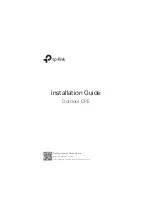
OM45T_
Rev N
Page 25
Thoroughly cover all previously primed areas with paint and blend the paint with any preexisting painted
surfaces.
5.2.4 Prepping & Painting Galvanized Surfaces
•
Remove all loose paint or rust using a scraper, wire brush, or sanding.
•
Wipe clean the surface to be painted with a soft cloth rag and acetone.
•
Allow the acetone to dry thoroughly before applying the finish coat of primer.
•
Apply a zinc-rich paint as the final finish, thoroughly covering any previously primed surfaces.
-
-
-
-
-
-
-
-
-
-
-
-
-
-
5.2.5 Priming & Painting Cleaned Jack Surfaces
Be sure to
read ALL of the following instructions/guidelines
BEFORE
proceeding
:
Surface Preparation
– Use acetone and a soft cloth rag to remove all grease from the surface to be coated.
Mixing
– Use a power mixer to bring the paint to a uniform consistency before using.
Thinning
– In the case of Jack Surfaces, thinning the paint is not normally required for most brush, roller, or
sprayer applications.
Using a Brush or Roller
– Using a
foam brush
, apply paint to surface with full, single strokes. Avoid any
re-brushing. Using a
medium nap roller
apply paint to surface in long, single rolls. Avoid rerolling. The
recommended dry film thickness per coat is 2 mils (50 micron).
Allow Each Coat to Dry Thoroughly
– Use the below chart (
Table 5.1
) to determine drying times. These
times are based on a 2 mil (50 micron) dry film thickness. Conditions such as higher film thickness, insufficient
ventilation, and/or cooler temperatures will likely require cure times to be extended. Allow the primer to dry
thoroughly before applying the topcoat. Application of the topcoat should be done based on the above
instructions.
Table 5.1: Cure Times
Temperature
Touch
Handle
Topcoat
75° F (24° C)
4 hours (Primer)
12 hours
8 hours
75° F (24° C)
5 Hours (Topcoat)
24 hours
5.3 Removing Backlash via Jack Adjustment
The backlash removal feature is a factory setting and does not normally require any additional adjustment.
However, as time and extended use can lead to the development of wear, it may eventually become necessary
to perform a Jac/Jack Anti-Backlash Adjustment in order to reduce/remove backlash.
Use the following procedure for Jac/Jack Anti-Backlash Adjustment:
1.
Loosen the Locknut (
item b
in
Figure 5-1
).
2.
Loosen the Setscrews (
item c
in
Figure 5-1
).
3.
In order to reduce backlash, rotate the Adjusting Cap (
item a
in
Figure 5-1
) in a clockwise direction until able
to feel resistance.
NOTE:
Do NOT over-tighten
the Adjusting Cap.
4.
Using a felt-tip marker (or equivalent), place a reference mark between the thread on the Adjusting Cap and
the Housing.
5.
Rotate the Adjusting Cap (
item a
) in a counterclockwise direction, in an amount equal to Dimension A
(labeled
“A”
in
Figure 5-1
) on the o.d. of the threads (match Jac/Jack model type, using the chart provided
in
Figure 5-1
).
6.
Tighten the Setscrews.
7.
While holding the Adjusting Cap (
item a
) stationary, tighten the Locknut (
item b
).
8.
Operate the Jack through the entire stroke, checking for tight spots.
NOTE:
If Jac/Jack has been used over only a portion of its stroke, the backlash should be adjusted in the least worn portion
of the screw.




































